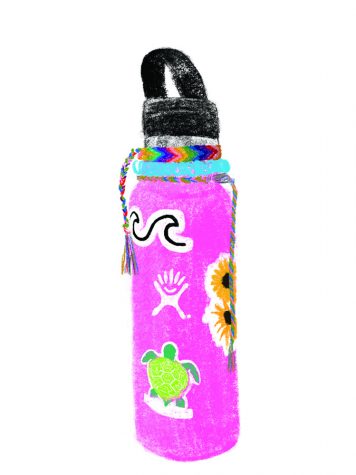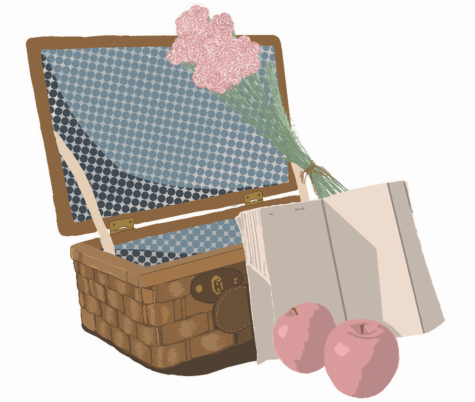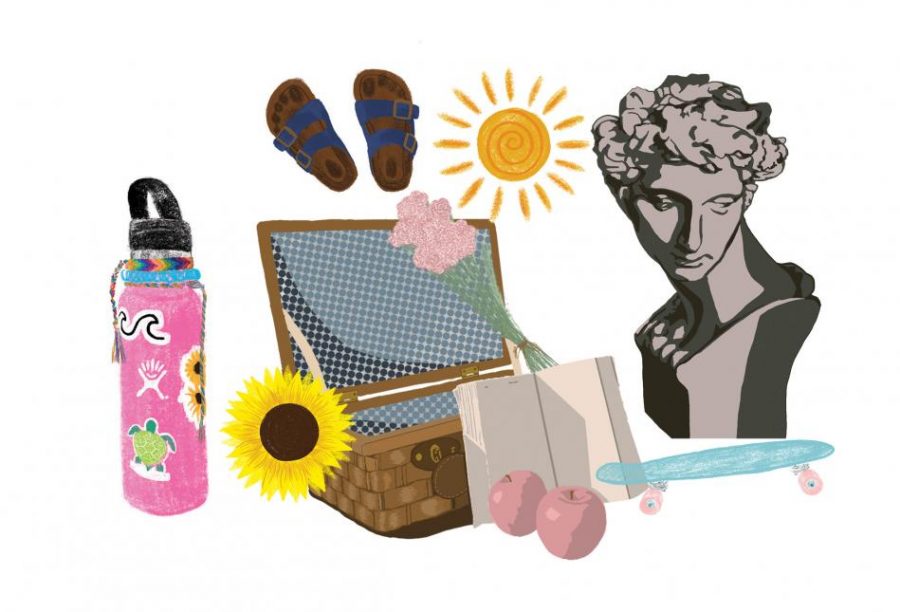How To: AesThet!c
The negative undertones of popular aesthetics are often hidden behind their perfectly curated styles
VSCO:
This specimen of teenager is often found running around at the beach with a Hydro Flask covered with stickers in one hand and a permanent peace sign in the other. Clad in denim shorts, a worn-in graphic tee and Birkenstock sandals, the classic VSCO girls can be seen driving a white Jeep whilst living out a perpetual summer and documenting it on social media for the rest of us to see.

The term VSCO girls and boys—a name which comes from a photo editing app—is attributed to those living out the California high school stereotype with a laid back personality and a questionably fashionable, beach-loving style. Hidden beneath their environmentally conscious and positive vibe, the connotations of this socially accepted category for stereotyping can be harmful. Especially for teenagers who are in the midst of discovering or creating their own identity. Two words: Climatography discrimination. Now hear me out—generally accepted ideas have to start somewhere. Because the VSCO style is dependent on maintaining a lifestyle of saturated-sunsets-on-the-beach, how can a person living in a colder climate ever relate to these bleached hair, tan bodied individuals?
Additionally, accumulating the supplies needed to fit the VSCO mold does not come at a cheap price. Deemed as “essentials” products like the Hydro Flask, Birkenstock Sandals and Urban Outfitters’ distressed tees are anything but an affordable essential for most. Acquiring these “must haves” to be considered “VSCO” also violates one of the better causes promoted by this aesthetic—environmentalism and sustainability. Like other trends that come and go, purchasing new clothes and accessories to try and achieve an aesthetic promotes great waste, especially if in a few months gothic Doc Martens are going to appeal more to you than your Birks. But then again, nothing says “I’m saving the planet” more than owning a name brand water bottle and the right shoes.
Dark Academia:

Strolling through cobblestone streets in London on a rainy night, you shiver and clutch your beige-toned wool coat and Burberry patterned scarf with extra vigor. You’ve just returned from a long day studying at the ivy-covered brick library immersing yourself in classic works, letting their romanticized pessimism about the world transport your psyche to new heights. Arriving at your Gothic styled apartment, you start a cozy fire and drink warm earl grey tea in hopes of warming your body and defrosting your soul from the eternal winter of life itself.
The Dark Academia aesthetic—one of the more recently popularized styles—is characterized by a romanticization of classical literature and music, Greek and Gothic architecture, ancient art and preppy fashion. Although deceivingly appearing positive because of its emphasis on academia, underlying this aesthetic are numerous toxic issues as there are with any attempt at creating an exclusive cliché. Primarily, Dark Academia photo sets, and their subsequent recreations by fans posted on social media, promote Eurocentrism by exclusively glorifying Western literature and Greek and Roman art. Furthermore, the photos almost always showcase white, thinner models achieving this style leaving those members of the BIPOC community and curvy individuals to feel like they have no place in this fantasy world. This aesthetic is a step backward to times of underrepresentation and the idolization of white beauty. How do we turn this around? It can start with a handful of Gen Zers blazing a new trail and posting content that reflects what they wish this aesthetic to include.
Soft Girl:

The last codified mainstream persona is the ultrafeminine soft girl who embodies a dreamy, angelic vibe created through a look of pigtails, glossy lips and faux freckles scattered on blushed cheeks and a button nose. Typically dressed in a pastel wardrobe consisting of mini skirts, heart and cloud patterned cardigans and dresses, soft girls earn their aesthetic association almost exclusively through their fashion style.
Unlike the VSCOs who tirelessly work towards ending global warming by saving one sea turtle at a time or the Dark Academics who remove themselves from the world by pretending to live in outdated times, being a soft girl requires nothing other than maintaining an ultra feminized appearance. Thus, by having one’s identity be solely based upon superficial notions of beauty and more specifically ultra femininity, the Soft Girl aesthetic promotes exclusivity based on unrealistic standards of appearance. Additionally, by including in the name itself that this aesthetic is binary, people of other gender identities are left feeling socially unaccepted for liking a fashion style deemed to be for girls, not women, girls only. And there is nothing cute, fluffy or nice about (in)advertently excluding others.
Finding a style to follow—or deliberately not follow—which speaks to your greater identity and lifestyle you choose to live, is hard enough for our social media addicted generation. But remembering to align ourselves with aesthetics we believe reflect the better part of our nature must never slip our minds—or at least not as quickly as these trends will come and go.
• Art by Hailey Hwang

I joined the C Magazine staff because of its commitment to representing diverse backgrounds by telling unheard of and creative stories about our community...







